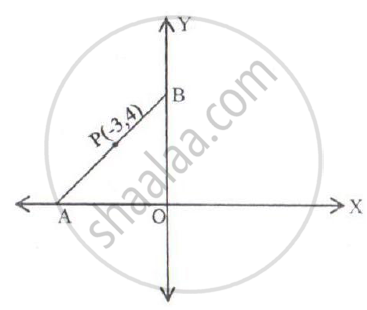Advertisements
Advertisements
Question
The vertices of a ΔABC are A(3, 8), B(–1, 2) and C(6, –6). Find:
(i) Slope of BC
(ii) Equation of a line perpendicular to BC and passing through A.
Solution
A (3, 8) , B(–1, 2) , C(6, –6)
(i) Slope of BC = `(y_2 - y_1) /(x_2- x_1) = (-6 - 2)/(6-(-1)) = (-8)/7`
∴ Slope of BC = - `8/7`
(ii) Slope of line perpendicular to BC `= (-1)/((-8/7)) = 7/8`
Required line ⇒ y - y1 = m(x - x1 )
y - 8 = `7/8 (x-3)`
`8y - 64 = 7x -21`
`7x - 8y + 43 = 0`
APPEARS IN
RELATED QUESTIONS
In the figure given below, the line segment AB meets X-axis at A and Y-axis at B. The point P(-3, 4) on AB divides it in the ratio 2:3. Find the coordinates of A and B.

The point P divides the join of (2, 1) and (−3, 6) in the ratio 2 : 3. Does P lies on the line x − 5y + 15 = 0?
Find the equation of the line passing through : (−1, −4) and (3, 0)
A, B and C have co-ordinates (0, 3), (4, 4) and (8, 0) respectively. Find the equation of the line through A and perpendicular to BC.
Write down the equation of the line whose gradient is `3/2` and which passes through P, where P divides the line segment joining A(−2, 6) and B(3, −4) in the ratio 2 : 3.
The line 4x + 3y = 11 bisects the join of ( 6,m) and (p,9). Find the value of m.
The line 5x - 3y +1 = 0 divides the join of (2,m) and (7,9) in the ratio 2: 3. Find the value of m.
Find the equation of a line passing through (2,9) and parallel to the line 3x + 4y = 11
P(5,3), Q(-4,7) and R(8,3) are he vertices of a traingles. Find the equation of the median of the traiangle from p.
ABCD is rhombus. The coordinates of A and C ae (3,7) and (9,15). Find the equation of BD.
